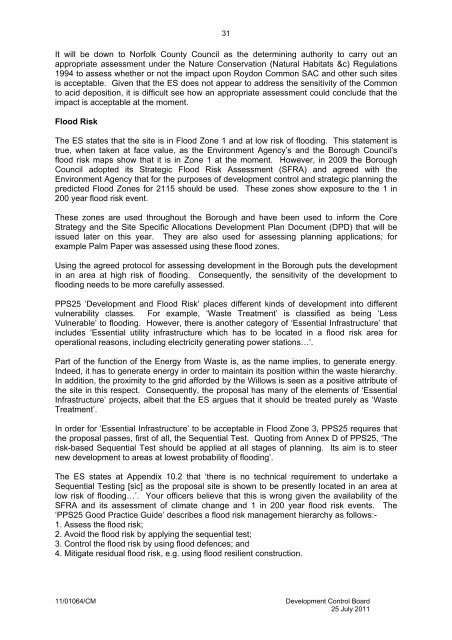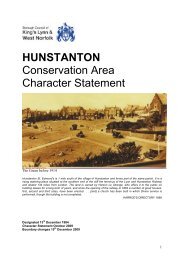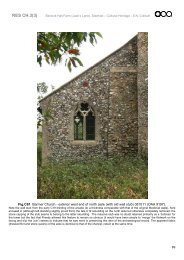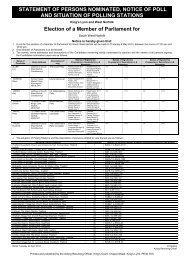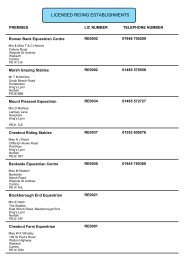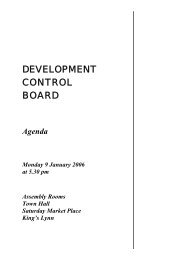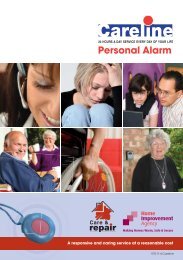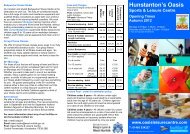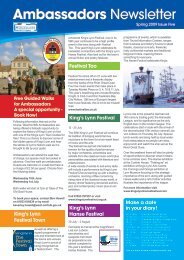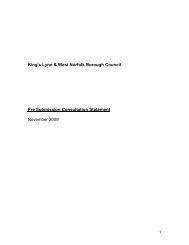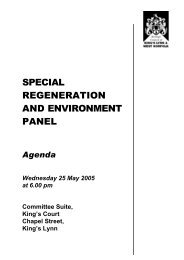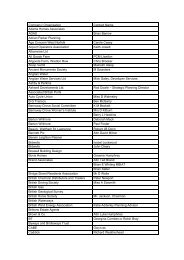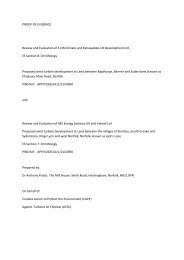11/00713/F - Borough Council of King's Lynn & West Norfolk
11/00713/F - Borough Council of King's Lynn & West Norfolk
11/00713/F - Borough Council of King's Lynn & West Norfolk
You also want an ePaper? Increase the reach of your titles
YUMPU automatically turns print PDFs into web optimized ePapers that Google loves.
It will be down to <strong>Norfolk</strong> County <strong>Council</strong> as the determining authority to carry out an<br />
appropriate assessment under the Nature Conservation (Natural Habitats &c) Regulations<br />
1994 to assess whether or not the impact upon Roydon Common SAC and other such sites<br />
is acceptable. Given that the ES does not appear to address the sensitivity <strong>of</strong> the Common<br />
to acid deposition, it is difficult see how an appropriate assessment could conclude that the<br />
impact is acceptable at the moment.<br />
Flood Risk<br />
The ES states that the site is in Flood Zone 1 and at low risk <strong>of</strong> flooding. This statement is<br />
true, when taken at face value, as the Environment Agency’s and the <strong>Borough</strong> <strong>Council</strong>’s<br />
flood risk maps show that it is in Zone 1 at the moment. However, in 2009 the <strong>Borough</strong><br />
<strong>Council</strong> adopted its Strategic Flood Risk Assessment (SFRA) and agreed with the<br />
Environment Agency that for the purposes <strong>of</strong> development control and strategic planning the<br />
predicted Flood Zones for 2<strong>11</strong>5 should be used. These zones show exposure to the 1 in<br />
200 year flood risk event.<br />
These zones are used throughout the <strong>Borough</strong> and have been used to inform the Core<br />
Strategy and the Site Specific Allocations Development Plan Document (DPD) that will be<br />
issued later on this year. They are also used for assessing planning applications; for<br />
example Palm Paper was assessed using these flood zones.<br />
Using the agreed protocol for assessing development in the <strong>Borough</strong> puts the development<br />
in an area at high risk <strong>of</strong> flooding. Consequently, the sensitivity <strong>of</strong> the development to<br />
flooding needs to be more carefully assessed.<br />
PPS25 ‘Development and Flood Risk’ places different kinds <strong>of</strong> development into different<br />
vulnerability classes. For example, ‘Waste Treatment’ is classified as being ‘Less<br />
Vulnerable’ to flooding. However, there is another category <strong>of</strong> ‘Essential Infrastructure’ that<br />
includes ‘Essential utility infrastructure which has to be located in a flood risk area for<br />
operational reasons, including electricity generating power stations…’.<br />
Part <strong>of</strong> the function <strong>of</strong> the Energy from Waste is, as the name implies, to generate energy.<br />
Indeed, it has to generate energy in order to maintain its position within the waste hierarchy.<br />
In addition, the proximity to the grid afforded by the Willows is seen as a positive attribute <strong>of</strong><br />
the site in this respect. Consequently, the proposal has many <strong>of</strong> the elements <strong>of</strong> ‘Essential<br />
Infrastructure’ projects, albeit that the ES argues that it should be treated purely as ‘Waste<br />
Treatment’.<br />
In order for ‘Essential Infrastructure’ to be acceptable in Flood Zone 3, PPS25 requires that<br />
the proposal passes, first <strong>of</strong> all, the Sequential Test. Quoting from Annex D <strong>of</strong> PPS25, ‘The<br />
risk-based Sequential Test should be applied at all stages <strong>of</strong> planning. Its aim is to steer<br />
new development to areas at lowest probability <strong>of</strong> flooding’.<br />
The ES states at Appendix 10.2 that ‘there is no technical requirement to undertake a<br />
Sequential Testing [sic] as the proposal site is shown to be presently located in an area at<br />
low risk <strong>of</strong> flooding…’. Your <strong>of</strong>ficers believe that this is wrong given the availability <strong>of</strong> the<br />
SFRA and its assessment <strong>of</strong> climate change and 1 in 200 year flood risk events. The<br />
‘PPS25 Good Practice Guide’ describes a flood risk management hierarchy as follows:-<br />
1. Assess the flood risk;<br />
2. Avoid the flood risk by applying the sequential test;<br />
3. Control the flood risk by using flood defences; and<br />
4. Mitigate residual flood risk, e.g. using flood resilient construction.<br />
<strong>11</strong>/01064/CM Development Control Board<br />
25 July 20<strong>11</strong><br />
31


